What is a Male Breast Reduction?
A male breast reduction is the most effective known treatment for gynecomastia, or enlarged male breasts. This cosmetic surgery procedure removes excess fat and glandular tissue to restore a flatter, firmer and more masculine contour to the chest.
Due to genetics, use of certain medications, or other unspecified reasons, some men develop the appearance of enlarged breasts. It is estimated that up to 50% of men in the United States experience some degree of gynecomastia during their lifetime. Gynecomastia can present at any age, and male breast reduction can be performed safely and successfully on teenagers and adult men alike.
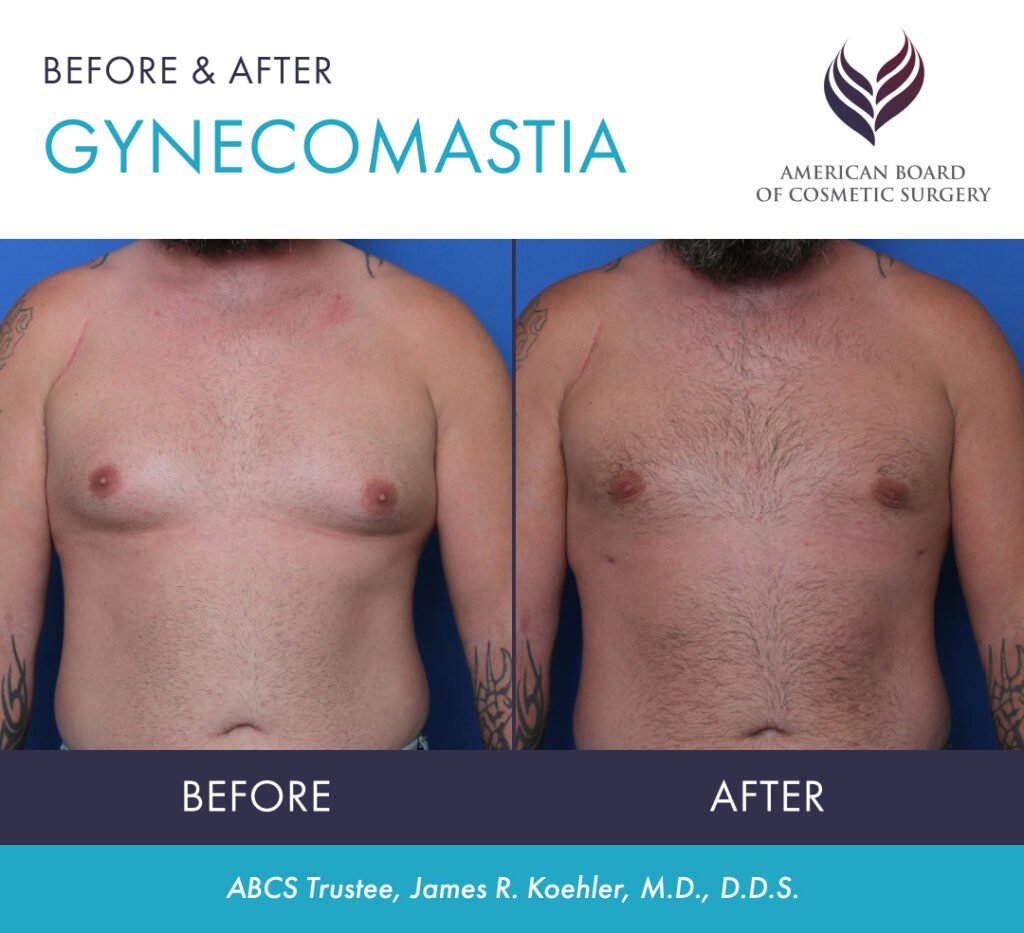
- Key Benefits
- Glossary
- Reduces excess breast tissue: Male chest reduction surgery can remove excess breast tissue and fat, reducing the appearance of gynecomastia (enlarged male breasts). This can result in a flatter, more masculine chest contour.
- Improves chest contour: In addition to reducing breast tissue, male chest reduction surgery can also improve the overall contour and shape of the chest, creating a more defined, sculpted appearance.
- Boosts self-confidence: Many men who undergo male chest reduction surgery report feeling more confident and comfortable in their own skin.
- Gynecomastia: A condition characterized by the enlargement of breast tissue in males, resulting in a more feminine chest appearance.
- Areola: The pigmented area surrounding the nipple on the breast.
- Bilateral gynecomastia: Gynecomastia affecting both breasts simultaneously.
- Unilateral gynecomastia: Gynecomastia affecting only one breast.
- Endocrine system: The system of glands and hormones that regulate various bodily functions and processes.
- Luteinizing hormone: A hormone produced by the pituitary gland that stimulates the production of testosterone in males.
- Pectoral muscles: The muscles located in the chest area, commonly referred to as the “pecs.”
- Hormonal imbalance: An abnormality in the levels or function of hormones in the body, which can lead to various physiological changes or conditions.
- Liposuction: A surgical procedure that removes excess fat deposits from specific areas of the body using suction.
- Anesthesia: The administration of medications or techniques to induce temporary loss of sensation or consciousness during medical procedures or surgeries.
- Man boobs: An informal term used to describe the enlarged breast tissue in males, often associated with gynecomastia.
Why have a male breast reduction?
While losing weight can help reduce the appearance of male breasts for some men, often times there is excess glandular tissue as well, causing even very lean patients to notice enlarged breasts. Currently, male breast reduction is the only consistently effective treatment for gynecomastia that has long lasting, if not permanent, results. Following this surgery, patients commonly say they feel comfortable going shirtless for the first time in years, and report an enhanced sense of self-confidence.
If you are uncomfortable or self-conscious about the appearance of your chest, or if you find yourself avoiding certain activities because you are afraid to show your chest, male breast reduction is an option to consider. With the help of a qualified cosmetic surgeon, the procedure offers dramatic, near immediate improvements with minimal scarring.
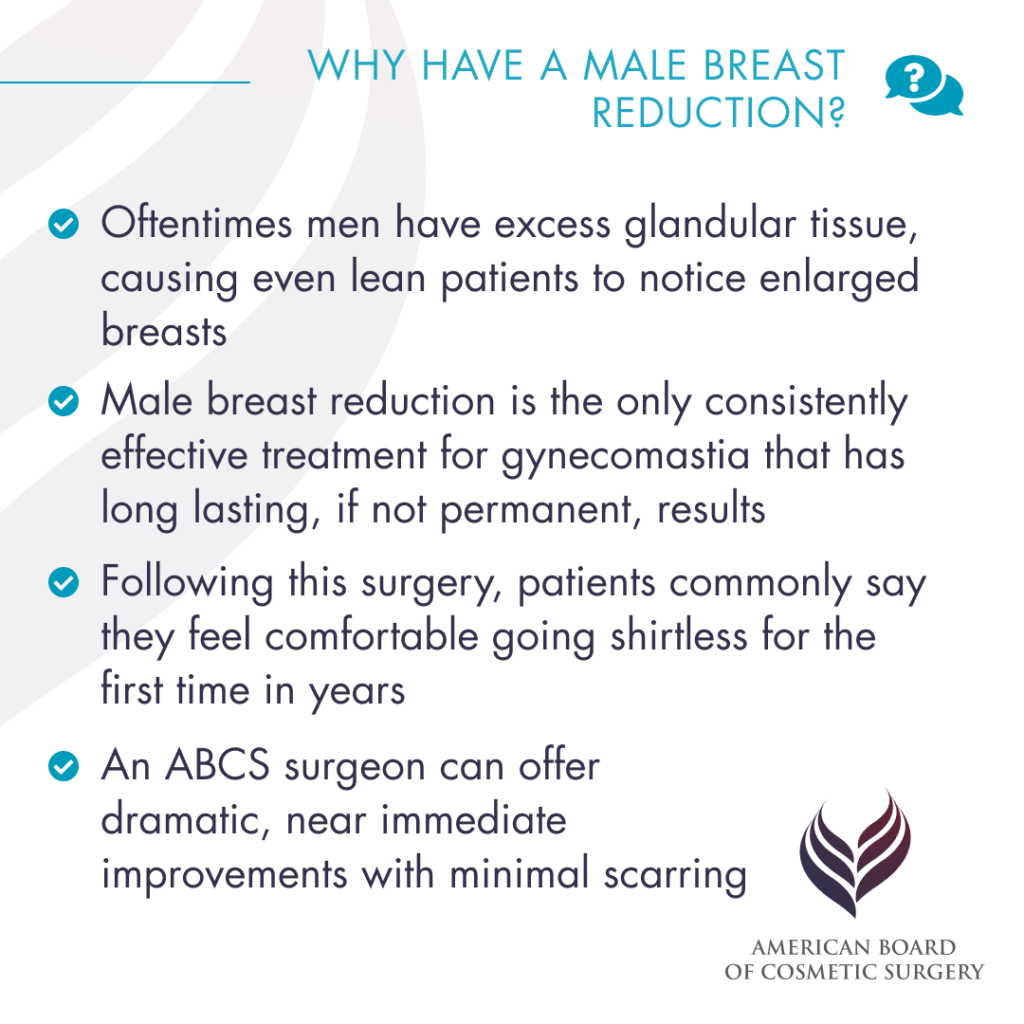
Choosing a Qualified Cosmetic Surgeon
Male breast reduction is one of the more straightforward cosmetic surgery procedures, but excellent results require a skilled approach that can only come from specialized training and experience. You need to vet potential doctors carefully to find a cosmetic surgeon who can perform the procedure safely and achieve the results you desire. Pay attention to 3 key factors when choosing a cosmetic surgeon for your male breast reduction procedure:
- Skill & Experience: make sure your cosmetic surgeon regularly performs male breast reduction as part of his or her practice. Ask how many procedures he or she has done, ask to see pictures of prior patients, and make sure you like what you see—this indicates that a cosmetic surgeon’s aesthetic style aligns well with yours.
- Board Certification in Cosmetic Surgery: ABCS board certified cosmetic surgeons are fellowship trained in all areas of cosmetic surgery, including liposuction and chest contouring, which may not be covered in plastic surgery or other surgical residencies. Also, by choosing a board certified cosmetic surgeon, you can take comfort in knowing your procedure will be performed in an accredited surgery center.
- Your Rapport with a Cosmetic Surgeon: you need to feel comfortable being candid with a cosmetic surgeon about your concerns and your medical history.
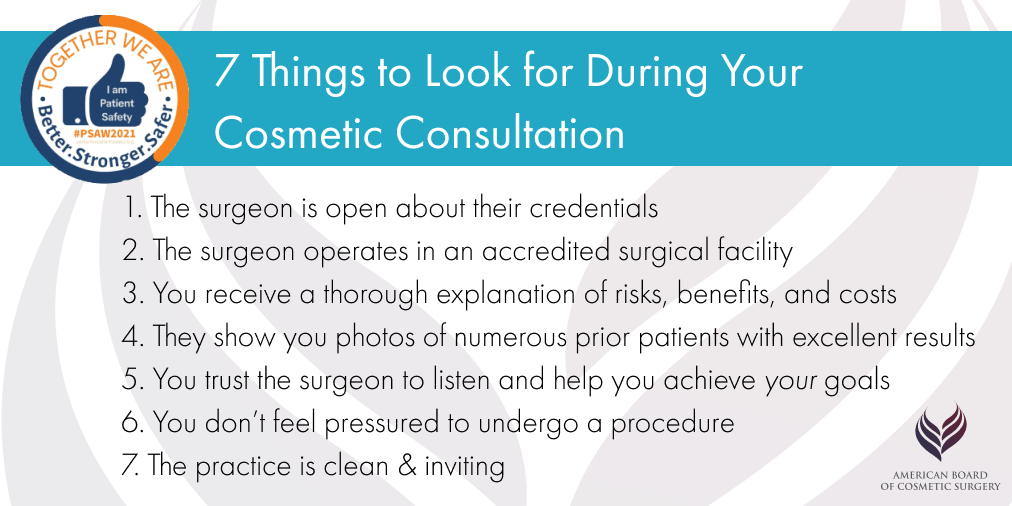
Treating Gynecomastia with Liposuction
Today, cosmetic surgeons are able to treat a growing number of gynecomastia patients using liposuction. This is due in part to advances in liposuction technology, which have resulted in a wider selection of less invasive techniques. However, surgeon skill plays an important role too, and it is important to choose a cosmetic surgeon who is trained in liposuction and has specific experience performing male breast reduction using liposuction. Learn more about liposuction surgery & techniques.
The procedure for treating gynecomastia with liposuction is typically performed using local anesthesia with sedation or general anesthesia, and involves a small incision on each side of the chest. Depending on your needs and your cosmetic surgeon’s preferred technique, incisions may be located along a portion of the edge of the areola or within the armpit. Through these incisions, your cosmetic surgeon will remove excess fat and/or glandular tissue, at the same time sculpting a new chest contour that looks natural to your body.

The recovery process following liposuction is typically quite tolerable. Patients are often given a compression garment to wear for the first few weeks after surgery; this helps to minimize swelling and offers support to the healing tissues. While vigorous exercise is typically off-limits for about 3 weeks, many men return to work or school within several days after their procedures. However, it is important to understand that everyone heals at a unique pace; your cosmetic surgeon will give you individualized instructions for recovery.
Male Breast Reduction with Tissue Excision
More severe cases of gynecomastia may require surgical tissue excision to achieve optimal results. Additionally, patients who have stretched, sagging skin around the breasts will usually require this approach. Tissue excisions allow a cosmetic surgeon to remove a greater amount of glandular tissue and/or skin that cannot be successfully treated with liposuction alone.
The location and length of the incisions depends on the extent of surgery needed, but are typically located around the edge of the areola (peri-areolar incision) or within the natural creases of the chest. A trained, qualified cosmetic surgeon will take care to place incisions so that the resulting scars are as inconspicuous as possible.
Male breast reduction with tissue excision is typically performed as an outpatient procedure using general anesthesia or local anesthesia with sedation. The recovery process is similar to that for liposuction; however, it is common for patients to experience soreness and some swelling. Typically, patients feel ready to return to work within 1 week of surgery, and a gradual return to exercise is usually permitted after the first couple of weeks.
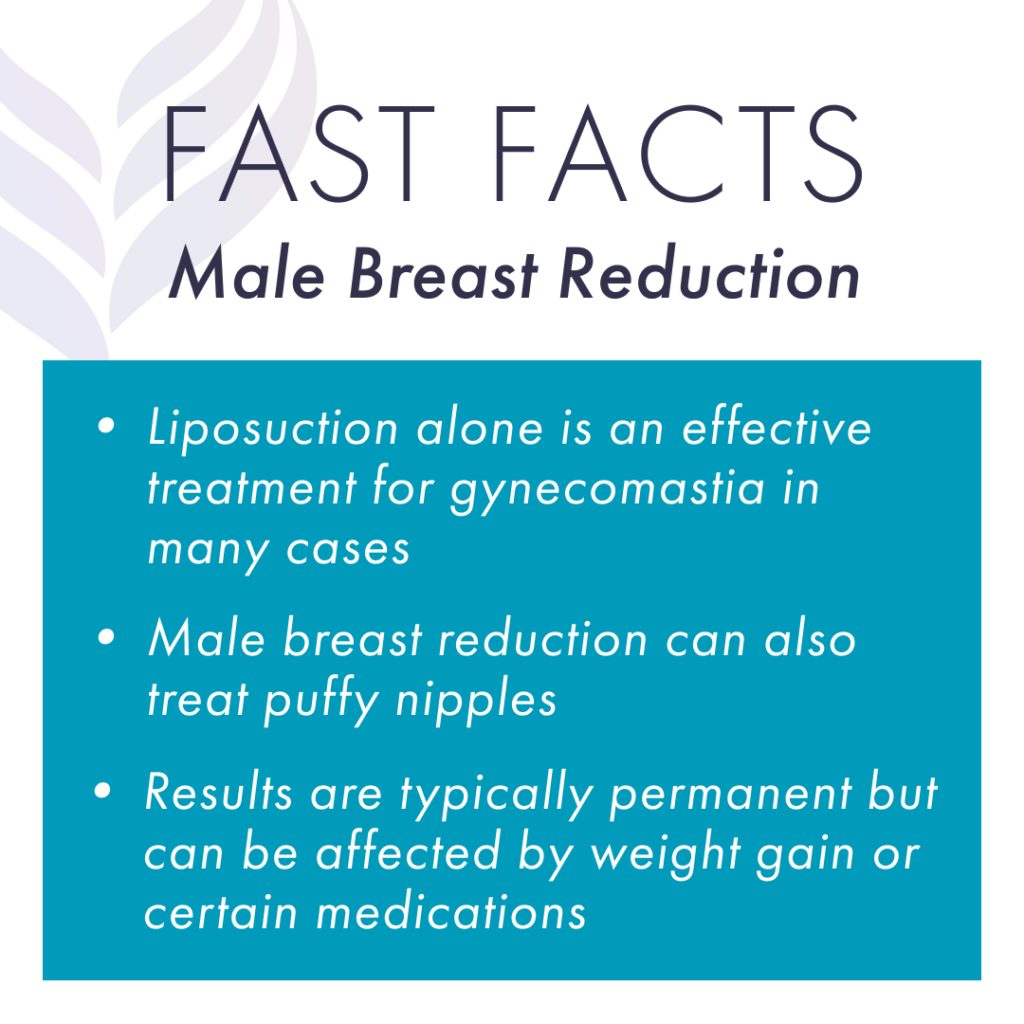
Life After Male Breast Reduction
After gynecomastia surgery, you should notice an immediate improvement in the shape and appearance of your chest. While you may feel sore for a few days, pain is usually minimal. While your cosmetic surgeon will likely prescribe some pain medication, many men find that over-the-counter options, such as Tylenol, is sufficient. If you are given a compression garment, wear it. This will enhance your comfort and help your chest heal optimally.
While every patient’s healing process is unique, most patients feel ready to return to work just a few days after a male breast reduction, depending on the nature of their work. Some men experience a loss of sensation in the treated areas after a male breast reduction, but this is almost always temporary. Any loss of sensation should gradually return over the months following your procedure.
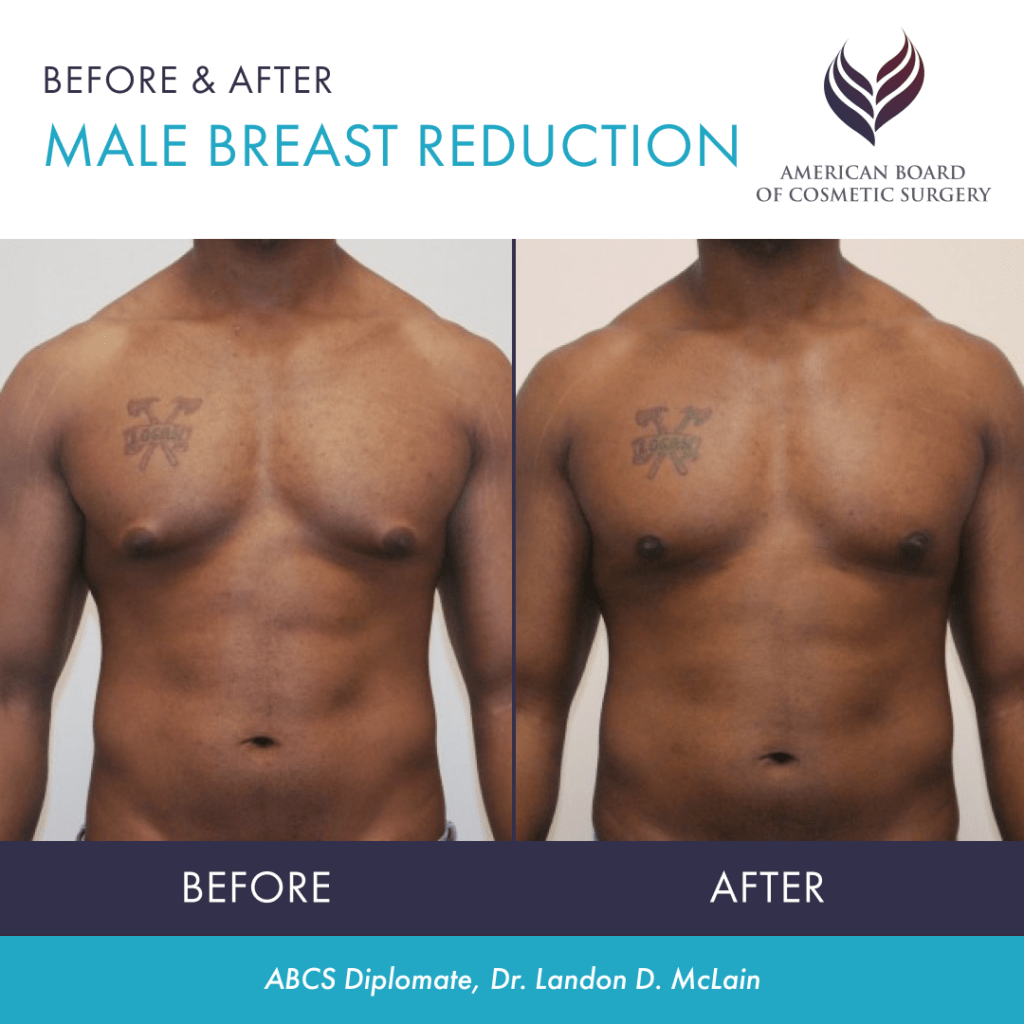
Maintaining Your Improved Chest Contour
Male breast reduction results are meant to be permanent – the excess fat, glandular tissue and skin removed are gone for good. However, it’s important to maintain a healthy lifestyle. Significant weight gain, steroid use, or certain medical conditions could result in a recurrence of gynecomastia. Additionally, drugs that influence testosterone levels could also affect your results. An experienced, board certified cosmetic surgeon can help you learn what to do to maintain your results for the long term.
If you are suffering from gynecomastia, male breast reduction could be the right solution to correct this condition and help you feel more confident in your appearance. The best way to learn about your options is to consult with a qualified cosmetic surgeon. Our ABCS Find-a-Surgeon tool will help you locate board certified cosmetic surgeons in your area.
References »
Taheri AR, Farahvash MR, Fathi HR, Ghanbarzadeh K, Faridniya B. The Satisfaction Rate among Patients and Surgeons after Periareolar Surgical Approach to Gynecomastia along with Liposuction. World Journal of Plastic Surgery. 2016 Sep;5(3):287-292. PMID: 27853693; PMCID: PMC5109391.
Johnson RE, Kermott CA, Murad MH. Gynecomastia – evaluation and current treatment options. Therapeutics and Clinical Risk Management. 2011;7:145-8. doi: 10.2147/TCRM.S10181. Epub 2011 Mar 28. PMID: 21479145; PMCID: PMC3071351.
Harold E. Carlson, Approach to the Patient with Gynecomastia, The Journal of Clinical Endocrinology & Metabolism, Volume 96, Issue 1, 1 January 2011, Pages 15–21, https://doi.org/10.1210/jc.2010-1720

